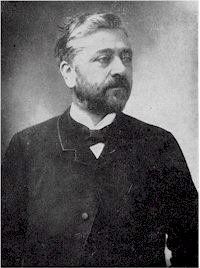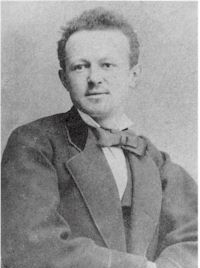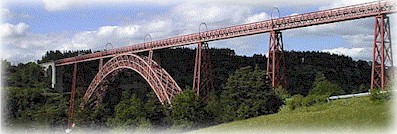|
Un peu d'histoire...
La Margeride, terre de
pierre, devient terre de fer
à Garabit. De cette alliance résulte le Viaduc qui, depuis plus d’un siècle,réunit les deux rives de la Truyère.
Défi architectural, vocation
utilitaire, objet de patrimoine, c’est un viaduc à trois dimensions qui
réunit les éléments air, terre et eau.
Des milliers de trains ont fait vibrer quotidiennement cette ossature métallique que des mains ont méticuleusement
assemblée durant les quatre années de construction.Chantier de fer, chantier " d’enfer ",
issu des ateliers
d’Eiffel, Garabit est une réalisation herculéenne dans un site paradisiaque.
|
|
The story ...
Margeride, ground of stone,
become iron ground with Garabit. From this alliance the Viaduct results which, since more d’un
century, joins together two banks of Truyère.
Architectural challenge, utility
vocation, object of inheritance, c’est a viaduct with three dimensions which joins together the
elements air, ground and water. Thousands of trains made vibrate daily this
metal framework that hands have méticuleusement
assembly during the four years of construction.
Iron building site, building site " the hell ", resulting from the workshops of Eiffel,
Garabit is a great realization in a paradisiac site.
|
|
Source des informations :
Guide CHAM INA " Balades à pied et à VTT Margeride Gévaudan "
|
|
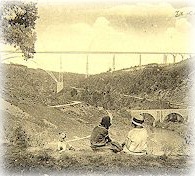
|
|
Les étapes de la construction
" On
construisit d’abord un pont de service en charpente, à 33 m. au-dessus du fond de la vallée.
Les deux premières années,
on exécuta les maçonneries. A partir du 1er août 1882,
débuta l’élévation des piles métalliques.
La première, côté Marvejols,
fut montée en
19 jours, la suivante en 46 jours, la troisième
en 68 jours, la quatrième
en 102 jours et le dernier côté Neussargues, en en 100 jours.
Simultanément étaient assemblés les premiers panneaux des travées du tablier.
L'opération consistait à construire ce tablier en
tout ou partie et à le glisser sur des rouleaux ou
des galets jusqu’à la rencontre des piles.
En 164 jours, le tablier côté Marvejols (282 m.)
fut monté par 35 ouvriers, et le tablier côté Neussargues (103 m.)
se posa en 60 jours.
|
|
Stages of construction
" One built in first a
gantry out of frame, to 33 m.
above the bottom of the valley. The first two years,
one carried out masonries From August 1, 1882,
the rise in the metal piles began.
The first, Marvejols side, were assembled in 19
days, the following one in 46 days, the third in 68 days, the fourth in 102 days and the last Neussargues side, in of 100 days.
At the same
time the first panels of the spans of the apron
were assembled.
At the same time the first panels of the spans
of
the apron were assembled. the operation consisted in building this apron in all or
part and
to slip it on rollers or rollers until with the meeting
of the piles. In 164 days, the apron side Marvejols (282 m.) was gone up by 35 workmen, and the apron side Neussargues (103 m.)
was posed in
60 days.
|
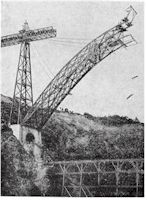
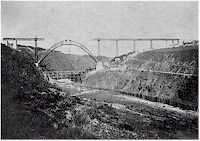
|
|
A chaque coup
de levier on obtenait en moyenne
un avancement de 11 cm, soit, à raison de 75 coups de levier à l’heure, une progression
de 8,25 m. Les deux tabliers furent ainsi amenés
en porte-à-faux, de part et d’autre des deux grandes piles, et le 24 juin 1883, le montage
de la grande arche commença.
|
|
With each blow of lever one
on average an
advance of 11 cm obtained, that is to say,
at a rate of 75 blows of lever with l’heure, a progression from 8,25 Mr. the two aprons were thus brought
cantilever, of share and d’autre of the two large piles, and on June 24, 1883,
the assembly of the large arch started.
|
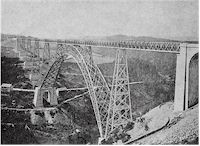
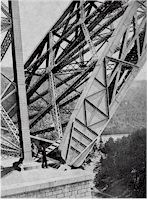
|
|
Dans la Notice sur le Viaduc de
Garabit,
Gustave Eiffel exposa lui-même, illustrations à l’appui, les étapes de la construction :
"on commença les préparatifs pour le levage de
l’arche en installant deux échafaudages importants en devant des soubassements des piles (…)
La partie supérieure de ces échafaudages fut
établie en courbe de manière à former un cintre
(…)
C’est sur ce cintre que l’on que l’on établit les premières des
retombées des arcs ; puis
l’extrémité de cette première partie de l’arc, celle qui s’avance
vers le vide, fut rattachée à l’aide de 20 câbles en acier au tablier, à l’aplomb de la grande
pile, et c’est alors que put
commencer le montage de l’arc en porte-à-faux
(…) "
|
|
In the Note on the Viaduct of Garabit,
Gustave Eiffelexposed itself, illustrations in the support, the stages of theconstruction : " one began the preparations for the lifting of
the arch by installing two important scaffolding while having
bases of the piles (…)
the higher part of this scaffolding was established
in curve so as to form a clotheshanger (…)
This is on this clotheshanger that we which one establishes the first of the repercussions of the arcs ; then the extremity of this first
part of the arc, that which s’avance towards the vacuum, was attached with help of 20 steel wire ropes with
the apron,
with the balance of the large pile, and it whereas could to begin the assembly of the arc cantilever (…) "
|
|
source : " Il était une fois
Garabit " E.Baillon, G.Brun.
Ostal del Libre, Aurillac 1992, pages 10-12.
|
Garabit et les chiffres
3 169 tonnes de fer, 41 tonnes d’acier,
23 tonnes de fonte,
15 tonnes de plomb.
678 768 rivets, 20 370 m3 de maçonnerie.
339 millions de francs de l’époque !
564.69 m. de long et 122 m. de haut.
Ecartement de l’arc à la base : 165 m.
Poids : 1 200.
Hauteur des piles : 60.74 m
Durée des travaux : 4 ans.
|
|
Garabit and figures
3 169 tons of iron,
41 tons of steel,
23 tons of cast iron,
15 tons of lead.
678 768 rivets,
20 370 m3 of masonry.
564.69 m. length and 122 m.. top.
Spacing of the arc to the base : 165 m.
Weight : 1 200.
Height of the piles : 60.74 m
Duration of the works : 4 years. |
|
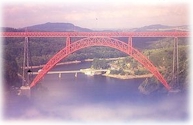
|
Le Viaduc de Garabit
en rouge poinsettia
La remise en peinture du
Viaduc de Garabit
a été décidée suite aux investigations détaillées
qui ont mis en évidence le vieillissement de la peinture et à l’apparition de rouille dans
les parties les plus exposées aux intempéries.
Des essais réalisés in situ ont
confirmé le choix
de la couleur, en référence aux teintes les plus couramment employées à la fin du XIXe siècle
( la teinte d’origine de la tour Eiffel était le rouge)
ou à l’exemple du Golden Gate Bridge de San Fransisco et du forth Bridge en Ecosse,
tous deux peints en rouge.
Le
" poinsettia " ou rouge " Gauguin " est
donc la
nouvelle couleur du Viaduc de Garabit.
Pour cette remise à neuf 38 tonnes
de peinture seront utilisés, couvrant une surface
de 51 000 m3.
|
|
T
he Viaduct of Garabit
in red "poinsettia"
The handing-over in painting of the Viaduct of Garabit was decided following the detailed investigations which underlined ageing of the
painting and with l’apparition of rust in
parts the most exposed to the bad weather.
Tests carried out in situ confirmed the choice
of the color, in reference to the colours most
usually employed at the end of XIXe century
(the original colour of the Eiffel tower
was the red) the Golden Gate Bridge of San Fransisco and the forth Bridge in Scotland, both painted in red.
The " poinsettia " or red " Gauguin " is
thus
the new color Viaduct of Garabit. For this handing-over with nine 38 tons of painting will
be used, covering a surface of 51 000 m3.
|
